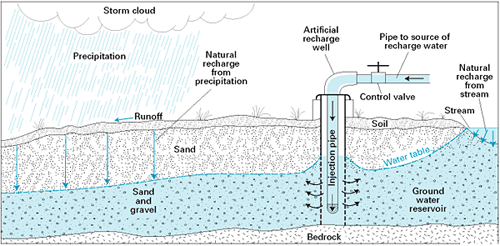Water on Earth is constantly on the move, following a familiar flow we call the water cycle: clouds precipitate rain and snow, which deposits liquid water in our lakes, rivers, and oceans, and which eventually evaporates into the atmosphere to form clouds all over again. But did you know that a large chunk of the water cycle is going on underneath your feet? Even in what seems like solid earth, water is present and moving.

In your mind, you may be picturing raging underground rivers miles beneath our feet, but groundwater is much closer to home. When rain and soil hit the ground, water enters the soil through a process called infiltration, very similar to how a sponge soaks up water through absorption on a much larger scale. Tiny gaps and fractures in soil and earth allow for water to sink into the Earth until it reaches the water table: the point where the soil is so saturated it can’t take in any more water. Even here, groundwater is constantly moving, thanks to the combined influences of gravity and pressure. Eventually, it will be discharged back to the surface or into a body of water; this process can take anywhere from days to centuries, depending on both its depth and the permeability and porosity of the surrounding rock.
While you may not be able to see groundwater in day-to-day life, its existence plays an important role in your local ecosystem. The depth of the water table, and, consequentially, its accessibility to the roots of plants, plays an important role in dictating what kind of flora can grow in an area. In times of drought, the groundwater supply can replenish bodies of water for extended duration until rainfall returns; and in vice versa, porous soil can take in additional water to mitigate flooding during extreme rainfall. Shallow depressions that breach the water table can form springs and oases, providing shelters of life in inhospitable regions. Even humans can depend on groundwater as a source of clean freshwater where it is otherwise unavailable, pumping it up using wells.
Just like any body of water, groundwater can be harmed by improper use. As water is drawn into the earth, it can bring with it contaminants, such as fertilizer, road salt, septic waste, and other runoff liquids. These substances can not only contaminate the water table, but bodies of water miles away due to the horizontal flow of groundwater. Overuse of well water beyond its replenishment by infiltration can also deplete groundwater and cause the water table to lower – if it reaches low enough, the well will be unable to reach and effectively become useless! Groundwater takes longer to deplete the deeper the water table lies, meaning that it can take centuries for some depleted wells to become viable again.
In several ways, groundwater is the foundation for a healthy ecosystem of plants, animals, and people. By minimizing pollutant exposure to our soil and keeping a balanced water usage, we can give back to a vital resource.
Resources:
- https://www.usgs.gov/special-topics/water-science-school/science/infiltration-and-water-cycle#overview
- https://www.usgs.gov/special-topics/water-science-school/science/groundwater-flow-and-water-cycle#overview
- https://phys.org/news/2023-01-road-salt-impact-groundwater-year-round.html
- https://groundwater.org/threats/contamination/
- https://www.usgs.gov/special-topics/water-science-school/science/contamination-groundwater
- https://www.usgs.gov/faqs/what-groundwater
- https://gw-project.org/the-importance-of-groundwater/
This article was contributed by Sean Kelly, OCSCD Volunteer.

Sean Kelly, Volunteer
Sean Kelly is a Biology major pursuing a lifelong interest in nature at the College of New Jersey. There are few things more wonderful to him than the animals and plants that live along the Jersey Shore. He is passionate about ecology and scientific outreach, and spends his off-time from college volunteering with local organizations, such as the Ocean County Soil Conservation District!
